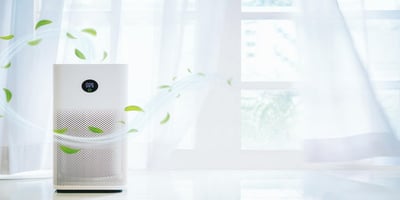Can You Use a Humidifier and Air Purifier in the Same Room?
Indoor air quality can ruin or enhance a house's comfort. Airborne particles like dust and pollen can aggravate allergies and make breathing difficult, and dry air can leave skin itching and throat irritation. Many people trust air purifiers to eliminate pollutants and use humidifiers to add moisture to the air.
If you need both, though, what then? Imagine a winter day when the heater runs continually, drying up the air, and allergies or pet dander hang about. Could one use an air purifier and a humidifier in the same area without them interacting negatively? Let's investigate their operation, compatibility, and ways to combine various devices to change your house surroundings.
How Humidifiers and Air Purifiers Work
Keeping the proper balance in your house's air could prove difficult. Air purifiers and humidifiers have significant but different uses. Analyzing how each gadget functions and what it offers helps one appreciate how they might interact.
What Does a Humidifier Do?
Humidifiers are made to fix one particular problem: dry air. Your indoor air might lose its natural moisture when humidity levels fall too low, usually in homes with lots of heating or during winter. This dryness affects not only comfort but also health conditions like cracked lips, dry skin, nasal congestion, and maybe aggravation of respiratory diseases.
Humidifiers raise humidity levels by releasing water vapor or a cool mist into the air. Some versions create a fine mist using ultrasonic vibrations, while others boil water into steam. Regardless of the technique, the aim is the same: to maintain an appropriate indoor humidity range of roughly 30–50%. This balance can lower static electricity, making your house seem more cozy and even guarding musical instruments or wooden furniture against warping or splitting.
How Does an Air Purifier Work?
While a humidifier targets dryness, an air purifier focuses on removing impurities from the air. Every breath you take indoors can contain microscopic particles—dust, pollen, pet dander, mold spores, or even bacteria and viruses. These contaminants can aggravate allergies, trigger asthma, or just make your home feel less fresh.
Air purifiers use a series of filters to clean the air. The most common are HEPA filters, which can trap particles as small as 0.3 microns, making them incredibly effective at removing allergens and pollutants. Some air purifiers also include activated carbon filters to eliminate odors, smoke, and harmful gases. Advanced models may even feature UV light or ionizers to neutralize bacteria, viruses, and other microorganisms.
By continuously cycling air through the filtration system, air purifiers help to significantly improve indoor air quality, making it easier and safer to breathe.
How Are They Different?
Air purifiers and humidifiers solve somewhat diverse facets of indoor air quality. Restoring moisture, a humidifier improves comfort—especially for dry skin, sore eyes, and respiratory health. An air purifier lowers airborne contaminants and allergens, guaranteeing cleanliness.
Consider this: whereas an air filter makes the air healthier, a humidifier makes the air feel better. Though their purposes may not coincide, they address two important components of indoor air quality.
.jpg?width=800&height=400&name=4108%20(1).jpg)
Can They Be Used Together?
You're not the only one who considers utilizing a humidifier and air purifier in the same room. Many question if these two technologies can work together without interfering. Good news: a humidifier and air purifier can work together to improve air quality and comfort with proper placement and use.
How They Operate Together
Humidifiers and air purifiers have separate goals, so they don't conflict. As humidifiers give moisture to the air, air purifiers remove contaminants. The two gadgets can work independently because these functions are separate.
However, placement is key. To prevent any issues, keep the devices far enough apart to avoid excess moisture from the humidifier reaching the air purifier directly. If water droplets or mist enter the purifier, they could clog or damage its filters, especially in models with HEPA filters.
Potential Concerns and How to Avoid Them
While using both devices together is safe, there are a few considerations to keep in mind:
- Excess Humidity Levels
Overusing a humidifier can dampen air, especially in compact or poorly ventilated spaces. Mold and germs can thrive in high humidity (over 60%), defeating the aim of an air filter. Manage humidity with a hygrometer and humidifier to avoid this. - Filter Performance
Air purifiers rely on their filters to trap particles effectively. If mist or water vapor from the humidifier reaches the purifier, it could saturate the filters or reduce their lifespan. This is why proper spacing between the devices is essential. Ideally, place them on opposite sides of the room to allow the air to circulate freely without any direct interference. - Room Size Matters
Using two devices in a small place may cause overcrowding or poor airflow. Ensure your devices fit the environment and avoid positioning them near walls or furniture that could restrict airflow.
When Combining Both Devices Makes Sense
There are several situations where using a humidifier and an air purifier together can be especially beneficial:
- During Allergy Seasons: An air purifier can reduce allergens like pollen and pet dander, while a humidifier can soothe dry, irritated sinuses caused by seasonal changes.
- In Winter: Heating systems often dry out the air, and a humidifier helps maintain comfortable moisture levels. Meanwhile, an air purifier tackles dust and other indoor pollutants that can build up when windows are closed.
- For Respiratory Health: If you suffer from asthma or chronic respiratory issues, combining these devices can create a cleaner, more comfortable breathing environment.
.jpg?width=800&height=400&name=photo_2024-12-13_21-24-07%20(1).jpg)
Benefits of Using Both Devices
Your house may be a paradise of fresh, relaxing air with a humidifier and air purifier. Each device adds moisture or removes pollutants, but together, they can improve your interior environment. Let's examine the main advantages of linking these gadgets.
1. Cleaner, Fresher Air
Air purifiers remove dust, pollen, pet dander, mold spores, and other contaminants. With a humidifier, the air is cleaner and more comfortable. Balanced humidity prevents airways from drying out, making it simpler to handle allergens.
2. Reduced Allergies and Irritation
Combining these gadgets can help allergy sufferers. The air purifier removes pollen and dust, while the humidifier moistens nasal passages and prevents throat dryness. The source and symptoms of allergy discomfort are addressed together.
3. Improved Respiratory Comfort
Dry air and airborne contaminants can worsen asthma and bronchitis. Both devices provide cleaner, moisturized air, reducing lung strain and inflammation. For chronic respiratory patients, this can change everything.
4. Healthier Skin and Eyes
Dry air can impair not only your breathing but also your skin and eyes. Common concerns in low-humidity or cold months are cracked, itchy skin and dry, irritated eyes. While an air purifier guarantees that this moisture isn’t combined with hazardous particles, hence providing a better atmosphere for your skin and eyes, a humidifier returns moisture to the air.
5. Balanced Indoor Environment
These devices handle humidity and cleanliness in indoor air. Balanced humidity lowers static electricity, prevents wooden furniture from cracking, and warms your environment. Cleaner air minimizes odors and prevents contamination. The mix makes the space feel fresher and friendlier.
6. Enhanced Comfort and Well-Being
The greatest benefit of using a humidifier and air purifier is increased comfort and well-being. Cleaner, humidified air can boost energy, focus, and mood while relaxing, working, or sleeping. This can greatly improve the quality of life for families with young children, retirees, or health issues.
Tips for Using a Humidifier and Air Purifier Together
Although using a humidifier and an air purifier in the same room may greatly enhance indoor air quality, proper use of both will yield the best benefits. These useful pointers will enable you to enhance their efficacy and steer clear of common mistakes.
1. Place the Devices Correctly
- Keep Them Apart: Arrange the air purifier and humidifier on opposing ends of the room. This stops the mist from the humidifier from being straight into the intake of the air purifier, therefore clogging filters or lowering performance.
- Avoid Corners or Obstructions: Make sure both devices have ample air circulation area around them. Steer clear of putting them next to drapes, bulky furniture, or walls since these could obstruct ventilation.
- Height Matters: To equally distribute moisture, set the humidifier on a level, raised surface. Depending on its design, the air purifier can be placed on the floor or in an elevated position, as long as it is not close to the humidifier either.
2. Monitor Humidity Levels
Getting the most out of both appliances depends on keeping the proper humidity level. Aim for a range of 30–50% relative humidity; this is perfect for comfort and will help to stop mold or dust mites from proliferating.
- Use a Hygrometer: A hygrometer is a small, cheap tool for tracking room humidity. This is a useful tool to make sure you are remaining in the ideal range.
- Adjust Settings: Most current humidifiers feature variable output levels. Starting low or medium, change depending on your hygrometer data.
3. Clean the Devices Regularly
- Humidifier Cleaning: Daily water tank and foundation cleaning help to stop mold and bacterial growth. Use a manufacturer-recommended cleaning solution or a combo of water and white vinegar. Replace wicks or filters per device directions.
- Air Purifier Maintenance: As advised—typically every 1-3 months for pre-filters and 6-12 months for HEPA or carbon filters—check and clean the filters on your air purifier. To clear dust, routinely clean the intake vents and outside surfaces.
4. Use the Right Devices for Your Room Size
Review the features of both devices to be sure they fit your room size. While an excessive humidifier might produce too much humidity or needless energy use, a humidifier that is too tiny or an air purifier could not be effective.
5. Use Them Consistently
For the best results, both devices should run regularly. If possible, use them together for several hours a day or overnight. However, avoid running a humidifier in a room that already feels damp or overly humid.
6. Choose the Right Type of Humidifier
- Cool Mist Humidifiers: These are less likely to interfere with air purifier filters than warm mist models.
- Ultrasonic Humidifiers: They are quiet and energy-efficient but may require more frequent cleaning to prevent mineral buildup.
7. Keep an Eye on Air Circulation
Make sure the room vents properly, particularly in a tiny space. Open a window sometimes to let fresh air in and stop humidity development that is too high.
Why These Tips Matter
When you combine a humidifier and air purifier, it's not just about turning on and letting them run. Avoiding issues such as clogged filters, mold growth, or ineffective performance depends mostly on correct placement, maintenance, and monitoring. When used properly, these appliances can complement one another to give your house cleaner, healthier, more comfortable air.


































.jpg)


.jpg?height=200&name=strategic-meeting-room-setting-staged-for-crucial-business-decisions%20(1).jpg)
.jpg?height=200&name=photo_2024-07-25_21-02-41%20(1).jpg)